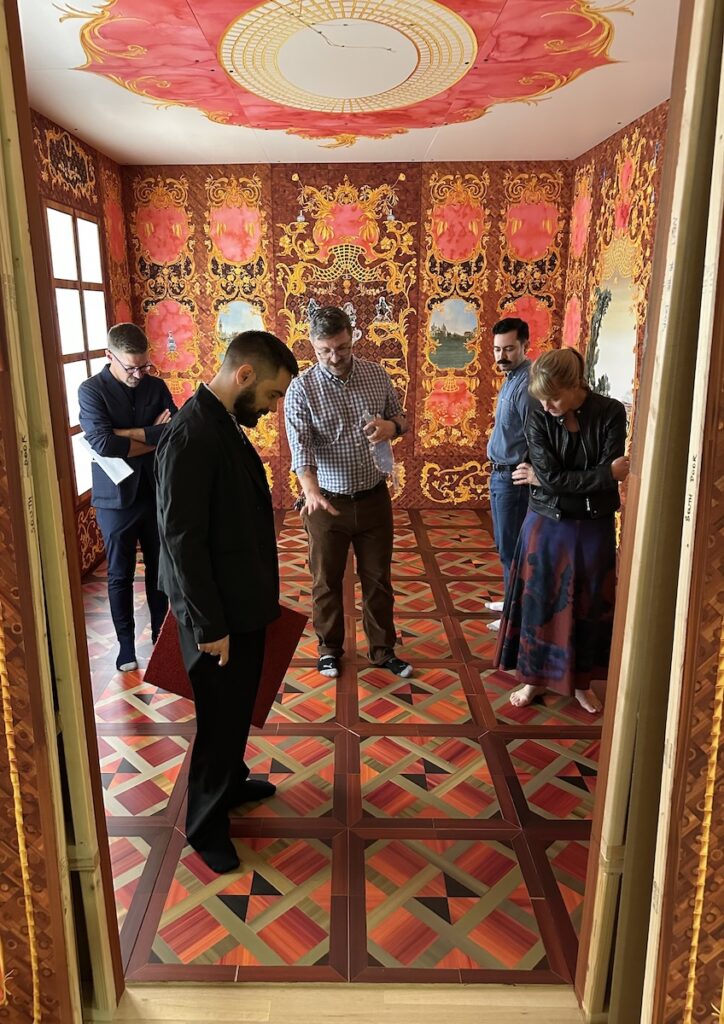On June 6, 2025, Resplendent Dreams: Reawakening the Rococo opened at the Indianapolis Museum of Art (IMA) in Indianapolis. The exhibition brings together three artists—Robert Horvath, Diego Montoya, and Anthony Sonnenberg—whose work responds to and reinvents the rococo. Their creations engage with queerness, visibility, and critique, engagements that are expansive in scope and deeply resonant for contemporary discussions.

Resplendent Dreams had been gestating for years—since at least 2019—and, with this lead time, the IU Indianapolis Museum of Art and the Indiana University Indianapolis Arts and Humanities Institute (IAHI) decided to partner by hosting a symposium on May 15-16, 2025. The focus of the symposium was on one object in the exhibition: Robert Horvath’s Room for the Lost Paradise, an imaginary period room made almost entirely of watercolor (Fig. 1).
Planning the symposium was a collaborative affair involving the exhibition’s curator, Michael Vetter (IMA); Robert Horvath (Indiana University Indianapolis); Chad Alligood (Voices in Contemporary Art) Meredith Martin (NYU); Makoto Harris Takao (University of Illinois, Urbana-Champaign); and myself. We followed a somewhat nonconventional approach to the symposium in that we knew we wanted some kind of research output, but we didn’t know what it would be. And, we wanted to create this research output quickly. In fact, we wanted to write it in a sprint on the symposium’s second day.
As a team of scholars who had mostly never met in person, we went into day one with the need to develop a sense of trust and collaboration that would lead us to where we needed to go. We convened at the IMA to see the unopened exhibition as a work-in-progress (Fig. 2). Both Vetter and Horvath gave talks on the exhibition and period room. We visited the museum’s labs, print room, and storage facilities, where we examined works that would either be on display or were related to the themes of Resplendent Dreams. The day was interspersed with discussions about the works on display, the eighteenth century, and how each of us saw our scholarship in conversation with the exhibition.

On the morning of the second day, we sat down to decide what we would develop in response to the exhibition and Horvath’s installation. Over breakfast, we decided on the format that has become this set of responses for Journal18. For the rest of the day, we wrote, we conversed, and we bounced ideas off of each other. By the end of the work day, we had much of the texts complete (except for minor revisions that we would make in the following weeks). As a result, the flavor of the following essays is one of spontaneity. These are essays-in-progress, just as we experienced an exhibition-in-progress. They represent thoughts beginning to form, even as the authors are forming intellectual bonds. Because of this, the essays blend into each other; they start where others leave off. They are initial reflections as well as conversations-in-motion.
Composing in this manner—as a group exercise within a short window, on site with creators and curators—was a bit of an experiment, one that surprised us at times. A number of common themes that we had discussed reemerged in the essays: queer futurities, critiques of consumption, reflections on mechanical production and reproduction, observations on environmental disaster and its entanglement in colonial processes. But there were some other, unexpressed themes that we noticed only when we read our essays aloud to each other. For instance, the room had evoked a range of sensory responses among the group: visual, tactile, audible, and olfactory.
In all, we found the process to be engaging, demanding, and edifying: one which could well serve as a model for scholarly analysis and communication in the digital age. We are pleased to present these essays as a rapid response roundtable, sharing them even as Resplendent Dreams remains on display.
Jason M. Kelly is founding Director of the IU Indianapolis Arts and Humanities Institute (IAHI); Professor of History at Indiana University Indianapolis; and Adjunct Professor of Africana Studies and American Studies
SYMPOSIUM RESPONSES
Curator’s Notes: Resplendent Dreams: Reawakening the Rococo – by Michael Vetter
Ornament and Algorithm – by Chad Alligood
Decay and Decadence – by Jason M. Kelly
Paradise Lost – by Meredith Martin
What the Elephant Heard – by Makoto Harris Takao
Cite this note as: Jason M. Kelly, “Room for the Lost Paradise: A Symposium” Journal18 (July 2025), https://www.journal18.org/7912.
License: CC BY-NC
Journal18 is published under a Creative Commons CC BY-NC International 4.0 license. Use of any content published in Journal18 must be for non-commercial purposes and appropriate credit must be given to the author of the content. Details for appropriate citation appear above.
